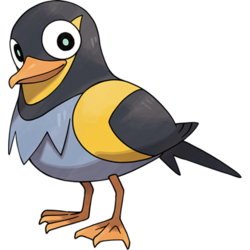From Bulbapedia, the community-driven Pokémon encyclopedia.

|
The subject of this article is a Pokémon which has recently been announced.
This article's contents will change as more information becomes available, perhaps abruptly. Please be cautious when adding information to this article, as rumors and speculation can often be confused with facts. Avoid any information on this subject which is not confirmed by reliable sources.
|
Wattrel (Japanese: カイデン Kaiden) is a dual-type Electric/Flying Pokémon introduced in Generation IX.
It evolves into Kilowattrel starting at level 25.
Biology
Wattrel is a tiny avian Pokémon. It has small webbed feet that are orange in color, light-blue feathers covering its chest area, and flight feathers mixed with colors of yellow and black. Its head is nub-like and colored black, but is comprised of a yellow crescent-like marking at the front. Just above the bottom of the arc is its fairly-long orange beak. Its eyes cover the tips of the crescent, which have white sclera, black iris, and teal pupils.
Wattrel flies in a specific way so that its wings are able to catch the wind. Its bones, in reaction to the wind, create electricity for Wattrel, and it uses this ability to dive into bodies of water to electrocute its prey. Their nests are located near the edge of coastal cliffs. The nests themselves have a crackling texture to them, and are known to be a popular delicacy throughout the Paldea region.
In the anime
Major appearances
Minor appearances
In the manga
In the TCG
- Main article: Wattrel (TCG)
Game data
Pokédex entries
| This Pokémon was unavailable prior to Generation IX.
|
| Generation IX
|
|
|
Paldea
#177
|
| Scarlet
|
When its wings catch the wind, the bones within produce electricity. This Pokémon dives into the ocean, catching prey by electrocuting them.
|
| Violet
|
These Pokémon make their nests on coastal cliffs. The nests have a strange, crackling texture, and they're a popular delicacy.
|
|
|
Game locations
| This Pokémon was unavailable prior to Generation IX.
|
|
|
In side games
Held items
Stats
Base stats
| Stat
|
Range
|
| At Lv. 50
|
At Lv. 100
|
40
|
|
100 - 147
|
190 - 284
|
40
|
|
40 - 101
|
76 - 196
|
35
|
|
36 - 95
|
67 - 185
|
55
|
|
54 - 117
|
103 - 229
|
40
|
|
40 - 101
|
76 - 196
|
70
|
|
67 - 134
|
130 - 262
|
Total: 280
|
Other Pokémon with this total
|
- Minimum stats are calculated with 0 EVs, IVs of 0, and (if applicable) a hindering nature.
- Maximum stats are calculated with 252 EVs, IVs of 31, and (if applicable) a helpful nature.
|
Type effectiveness
| Under normal battle conditions in Generation IX, this Pokémon is:
|
|
|
|
|
|
|
|
|
|
|
|
|
Learnset
|
|
|
|
- Bold indicates a move that gets STAB when used by Wattrel
- Italic indicates a move that gets STAB only when used by an Evolution of Wattrel
|
|
|
|
|
- Bold indicates a move that gets STAB when used by Wattrel
- Italic indicates a move that gets STAB only when used by an Evolution or an alternate form of Wattrel
|
|
|
|
|
- Moves marked with an asterisk (*) must be chain bred onto Wattrel
- Bold indicates a move that gets STAB when used by Wattrel
- Italic indicates a move that gets STAB only when used by an Evolution of Wattrel
|
Side game data
Evolution
Sprites
Trivia
Origin
Wattrel may be based on a storm petrel. Its design may also be based on either the myth of storm petrels indicating bad weather at sea, or a play on the words "storm petrel" as a whole, as lightning is usually present in storms. The shape of its head and eyes resemble an aviator hat. The Violet Pokédex entry refers to an edible bird's nest which is a delicacy enjoyed in the eastern parts of Asia.
Name origin
Wattrel may be a combination of watt and petrel.
Kaiden may be a combination of 海 kai (sea), 雷電 raiden (thunder and lightning), and 海燕 kaien (northern storm petrel).
In other languages
| Language
|
Title
|
Meaning
|
 Japanese Japanese
|
カイデン Kaiden
|
From 海 kai, 雷電 raiden, and 海燕 kaien
|
 French French
|
Zapétrel
|
From zap and pétrel
|
 Spanish Spanish
|
Wattrel
|
Same as English name
|
 German German
|
Voltrel
|
From Volt and petrel
|
 Italian Italian
|
Wattrel
|
Same as English name
|
 Korean Korean
|
찌리비 Jjiribi
|
From 찌릿찌릿 jjirit-jjirit and 바다제비 badajaebi
|
 Mandarin Chinese Mandarin Chinese
|
電海燕 / 电海燕 Diànhǎiyàn
|
From 電 / 电 diàn, 海 hǎi, and 海燕 hǎiyàn
|
 Cantonese Chinese Cantonese Chinese
|
電海燕 Dihnhóiyin
|
From 電 dihn, 海 hói, and 海燕 hóiyin
|
|
|
|
|
|
|
|
Related articles
External links

|
This Pokémon article is part of Project Pokédex, a Bulbapedia project that aims to write comprehensive articles on each Pokémon species, as well as Pokémon groups and forms.
|




